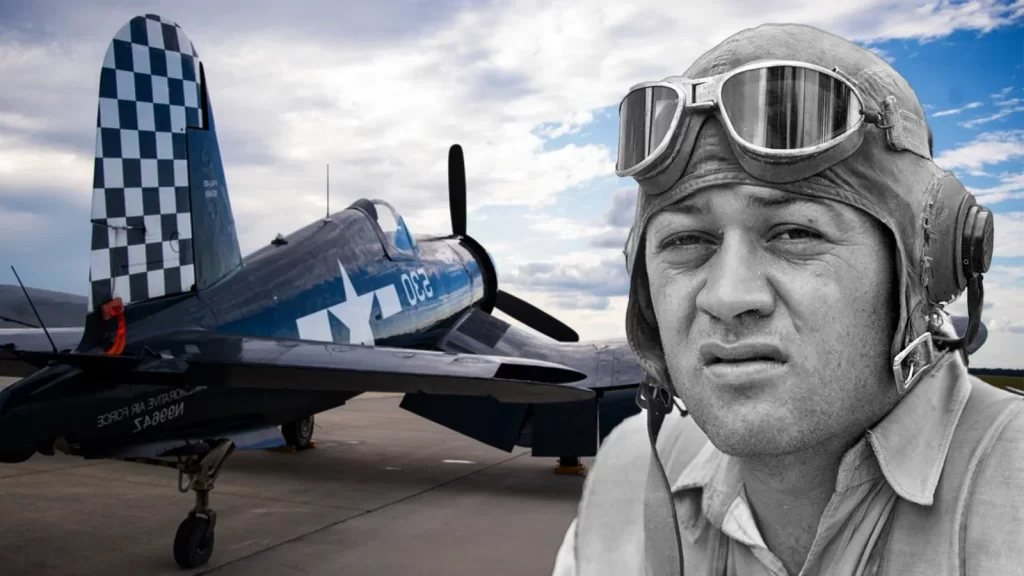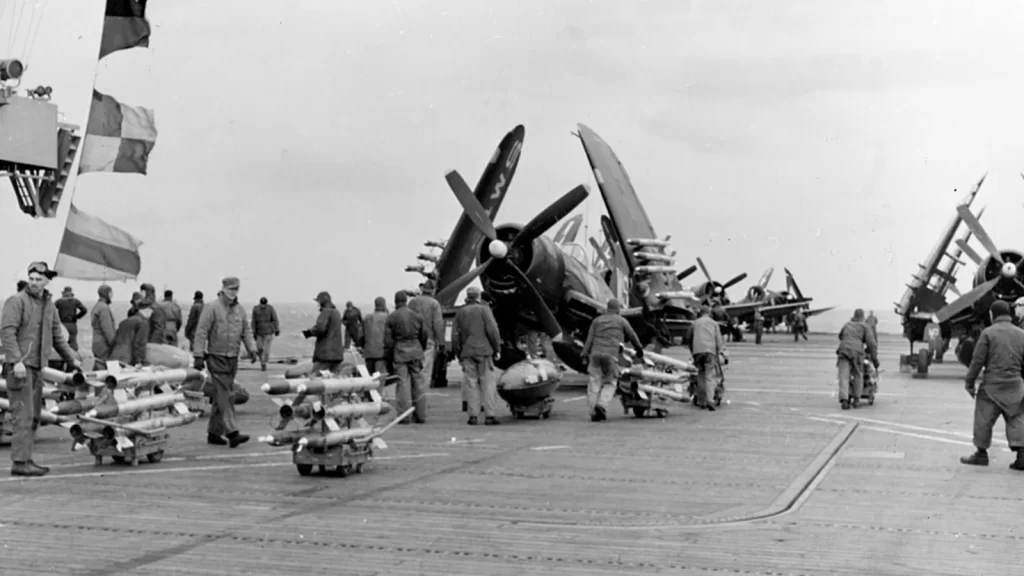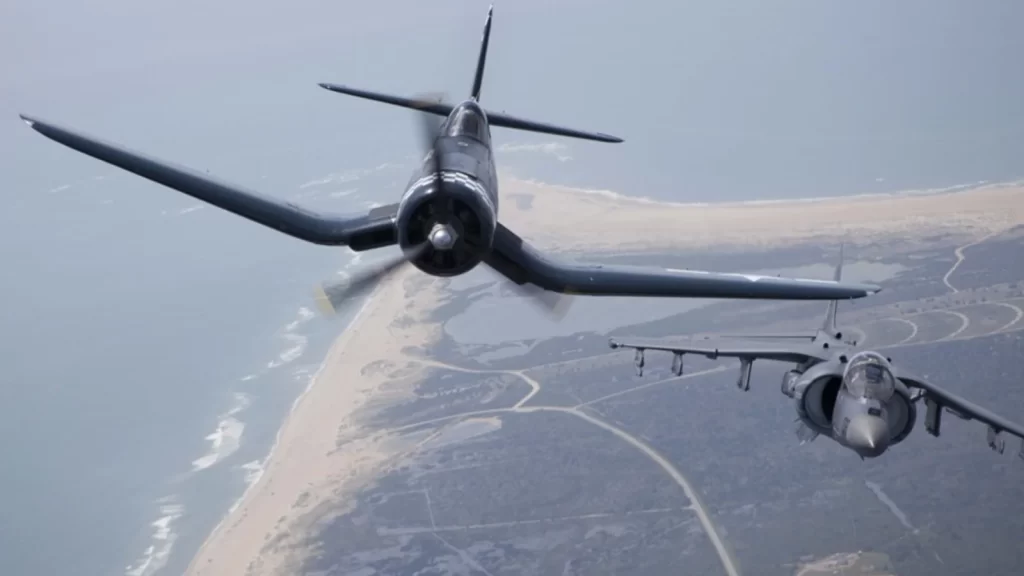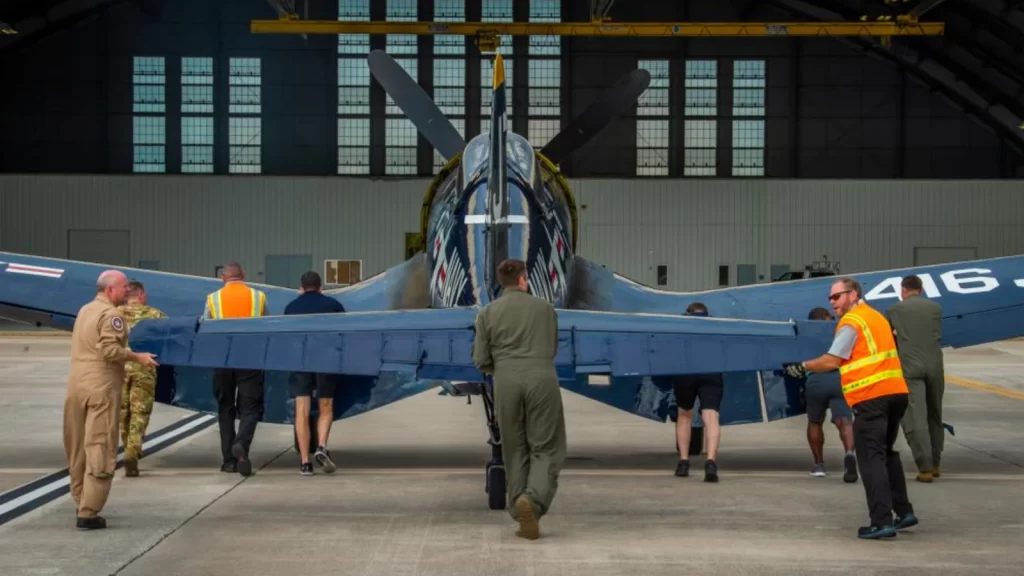𝙒𝙃𝙄𝙎𝙏𝙇𝙄𝙉𝙂 𝘿𝙀𝘼𝙏𝙃: 𝙃𝙊𝙒 𝙏𝙃𝙀 𝙁4𝙐 𝘾𝙊𝙍𝙎𝘼𝙄𝙍 𝘾𝙃𝘼𝙉𝙂𝙀𝘿 𝘼𝙈𝙀𝙍𝙄𝘾𝘼𝙉 𝘼𝙑𝙄𝘼𝙏𝙄𝙊𝙉
Circling high above Bougainville, Gregory “Pappy” Boyington peered through the glass of his F4U Corsair’s cockpit at the Japanese air base below. He was in charge of 24 other Marine Corsairs from the legendary Black Sheep Squadron, and their plan was simple: lure as many Japanese pilots into the sky as they could and kill them.
Boyington’s Black Sheep Squadron was already a combat-tested unit. They had shot down 23 Japanese planes during their first two weeks in the Pacific. Boyington himself had also previously flown combat missions in China, as a volunteer with the famous Flying Tigers. But for all their experience, Boyington and the other Corsair pilots were about to face their biggest battle yet. As the Black Sheep flew above Bougainville’s Kahili airfield, an estimated 60 Japanese planes scrambled to meet them.
The Corsairs could dive and climb faster than the enemy’s Mitsubishi A6M Zeros. Each Corsair also had the additional firepower of six .50-caliber machine guns mounted on their wings. With those advantages, the Corsairs made quick work of the Zeros. Of the 60 enemy aircraft that took to the sky, 20 were shot down. Not a single Corsair or Marine pilot was lost in the battle.
Marine Col. “Pappy” Boyington was shot down after racking up 28 air-to-air kills. He was presumed dead until he emerged from a Japanese prisoner-of-war camp at the end of WWII. Composite by Coffee or Die Magazine.
The Black Sheep saw just 87 days of combat during the entire war. In that time, however, they shot and damaged 203 Japanese aircraft and tallied 97 confirmed kills. And while skill behind the stick and good training are largely responsible for their many victories, the Black Sheep can also attribute much of their success in the sky to the F4U Corsair.
A ‘Hose-Nose’ Star Is Born
Three years before the United States entered World War II, the US Navy got to work developing a single-engine fighter aircraft that was faster and better armed than those of America’s enemies. The Navy also wanted its new fighter planes to be better suited for duty aboard aircraft carriers. The end result of this undertaking was the Vought F4U Corsair.
The Corsair was built with foldable wings. These inverted, gull-shaped folding wings allowed for more of the planes to fit on the deck of carriers. The curved wings also cut down on drag and provided space for retractable landing gear, further increasing the fighter’s speed.
An F4U Corsair flies during the Thunder Over South Georgia Open House Nov. 7, 2015, at Moody Air Force Base, Georgia. US Air Force photo by Senior Airman Ryan Callaghan.
When the first prototype was completed in 1940, the Corsair boasted the largest engine, propeller, and wingspan of any Navy fighter plane. It was also the first US fighter to fly faster than 400 mph.
In order to house its massive Pratt & Whitney R-2800 Double Wasp engine, the Corsair was built with an enlarged “nose.” The extra space between the single-seat cockpit and the propeller made it difficult for pilots to see directly in front of the aircraft, which, in turn, made carrier landings even more challenging. For this reason, the first Corsair pilots took to calling the bulky new fighter “hose nose.”
The Navy Didn’t Like It, So They Gave It to Marines
Not unlike the V-22 Osprey, F4U Corsairs were designed for carrier duty but initially proved less than optimal for service at sea.
During its maiden flights, the Corsair’s left wing tended to stall prematurely, sending the plane careening toward the water. The aircraft also leaked more oil than other fighters and the spatter often obscured the windshield. Even more problematic, sudden increases in speed could sometimes cause the plane to inadvertently flip over.
US Navy crewmen arm US Marine Corps Vought F4U-4B Corsairs of Marine Fighter Squadron 323 “Death Rattlers” with rockets and napalm canisters aboard the escort carrier USS Badoeng Strait during operations off the Korean coast Dec. 1, 1950. US Navy photo via Wikimedia Commons.
The F6F Hellcat, the Navy’s other carrier-based fighter plane, proved to be easier to fly on and off carriers, especially for new pilots. The Navy therefore initially approved Corsairs for land-based operations only. That designation left the fast-flying Corsair in the hands of the Marines.
Marine Corps pilots quickly fell in love with the Corsair. They gave it a new nickname, “whistling death,” for the unique sound it made when diving. With its powerful engine and formidable armaments, the Corsair eventually earned a reputation for being one of the best planes of the war. Between 1943 and 1945, Corsairs boasted a kill-to-death ratio of 11:1 and had the lowest attrition rate of any fighter plane in the Pacific.
Before the A-10 Warthog, the F4U Corsair Was the King of Close Air Support
In addition to dominating air-to-air combat, Corsairs helped pioneer the use of close air support.
Following the battle for Tarawa — where supporting Navy pilots had no means of communicating with ground troops — the Marine Corps recognized a need to establish a direct line of communication between grunts and Corsair pilots. To bridge the communication gap, the Marines created air liaison parties, which saw dismounted aviators embedded with infantrymen. There, they could speak directly to low-flying Corsair pilots and help direct their ordnance to where it was needed. This innovation paved the way for today’s joint terminal attack controllers.
Corsairs continued to fly in that capacity in the battles of Peleliu, Iwo Jima, and Okinawa. During the Korean War, F4U Corsairs again proved to be vital assets to ground forces. They provided accurate close air support at the Inchon landings and again at the Chosin Reservoir.
A Marine Corps AV-8B Harrier and vintage F4U Corsair fly side by side over the 2012 Marine Corps Air Station Cherry Point Air Show. US Marine Corps photo by Lance Cpl. Scott L. Tomaszycki.
Meanwhile, the advent of jet engine aircraft was beginning to make propeller planes obsolete. Yet, despite their outdated design, Corsairs proved they could still hold their own. In 1952, for example, Marine Capt. Jesse Folmar took on a Soviet MiG jet in his F4U Corsair.
“A gray trail of fuel vapor began to stream from the MiG, and this quickly turned into billowing black smoke,” Folmar recalled in Warren Thompson’s book F4U Corsair Units of the Korean War. “He nosed over slightly and seemed to lose acceleration. […] I glanced down and saw the flaming MiG hit the water vertically.”
Remarkably, Folmar’s air-to-air kill against a Soviet jet is not the wildest Corsair kill recorded.
The Strange Case of the F4U Corsair’s First and Last Kills
On Feb. 14, 1943, during what became known as the Saint Valentine’s Day Massacre, a squadron of Corsairs was attacked while escorting several American bombers in the Pacific.
Nine American planes and one Japanese Zero were lost during the ensuing skirmish. The Zero went down after colliding midair with a Corsair piloted by Lt. Gordon Lyon Jr. Both pilots were killed, marking the first confirmed kill ever attributed to a Corsair.
MacDill Air Force Base personnel push the “Korean War Hero” F4U-4 Corsair into a hangar at MacDill Air Force Base, Florida, March 22, 2022. US Air Force photo by Airman 1st Class Michael Killian.
Twenty-six years after Lyon Jr. lost his life, a Honduran pilot made the last ever confirmed kill from the cockpit of a Corsair. That story is even more remarkable.
During the Football War — a 100-hour conflict in 1969 waged between Honduras and El Salvador — Corsairs flew on both sides. While piloting an aging F4U Corsair, Honduran Air Force Capt. Fernando Soto shot down three El Salvadoran planes, including two Corsairs.
Those were the last planes ever shot down by a Corsair. And to this day, Soto remains the only pilot with three confirmed kills over the American continents and the only Corsair pilot to down another Corsair in combat.
Today, more than half a century later, only an estimated 10 to 15 Corsairs remain flyable in the United States, yet the iconic gull-winged plane endures as one of the most beloved fighters in American aviation history.